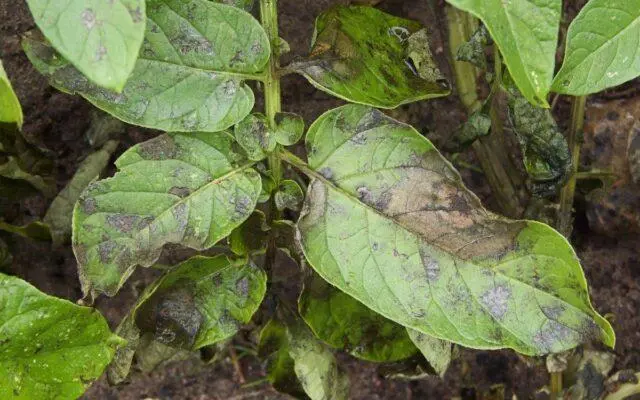Contents
Eggplant diseases in the open field are most often associated with improper care. For example, fungal infections occur due to excessive watering, dense planting, unbalanced top dressing. Therefore, for prevention, it is necessary to ensure proper care, as well as follow the recommendations for planting.
Causes of diseases
Many eggplant diseases in the open field spread against the backdrop of adverse weather. If the summer is rainy and cool, temperature drops are periodically observed, this contributes to the development of fungal infections. In some cases, prolonged drought can also be a provoking factor.
But most often the reasons are associated with improper care:
- early transplantation in open ground;
- too tight fit;
- sunburn (especially in seedlings);
- excessive or insufficient watering;
- unbalanced supplements.
Eggplants are quite demanding plants. Therefore, when grown outdoors, they need to be well cared for.
Fungal diseases of eggplant and their control
Most often, plants suffer from fungal infections. The main types of eggplant diseases with a photo of the leaves and a description of the methods of treatment are presented below.
Blackleg
This disease is also called root collar rot. It is associated with fungi that live in the surface layer of the soil. It spreads against the background of high humidity. After the root neck, it affects the sprouts themselves. The stems turn black, soften, become brittle. As a result, they can break down and the plants die.
The main factors contributing to the spread of the disease in open ground are dense planting, violation of the irrigation norm, and lack of air flow. There is no adequate treatment – diseased bushes are destroyed. Healthy ones are best transplanted into the soil, which is previously disinfected with fungicides.

Symptoms of blackleg in the open field
Mučnistaâ rosa
The photo and description of this eggplant disease show that it primarily affects the lower leaves. They have a white coating on them. Further, the infection spreads to the upper foliage, after which the fruits are already covered with a white coating, resembling flour, and crack.
For the treatment of eggplant in the open field from this disease, biological preparations are used, for example, Trichodermin, Gaupsin. They are effective and safe at the fruiting stage. If the plant has not yet formed ovaries, chemical agents can also be used, for example, Skor, Bordeaux liquid, Ordan and others.
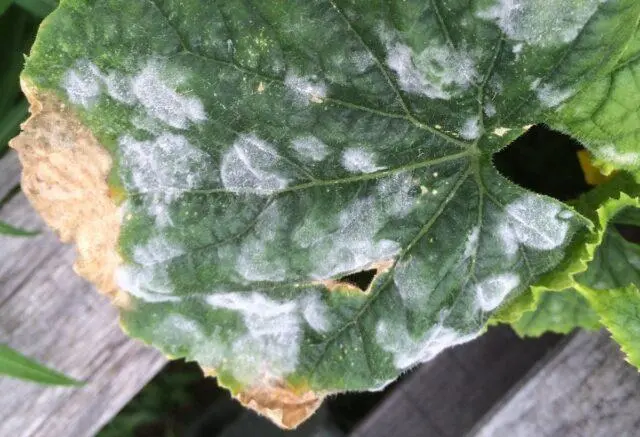
A leaf affected by powdery mildew is easy to visually identify
Fitoftoroz
Late blight is a fungal infection that affects eggplants and other nightshades in the open field. Main features:
- brown spots;

- white coating on the underside of the leaves;
- fruit rotting – first in separate places, and then entirely.
To prevent this disease, crop rotation in the open field is required. Eggplants should not be grown in the same place for more than 3-4 years in a row, and they should not be planted after other nightshades, such as tomatoes or peppers.
Plant seeds are disinfected in a solution of potassium permanganate, and the plantings themselves are treated with copper-containing preparations. Spraying against diseases in the open field should be started even before the fruit ripens. To do this, you can use the following tools:
- “Oxychom”;
- “Ridomil Gold”;
- “Acrobat MC”;
- “Metaxil”.
Cerkosporoz
Cercosporosis is one of the most common diseases that affects eggplants in the open field. It spreads to leaves, shoots, stalks. The main features are:
- pale yellow spots;
- their increase in size;
- falling leaves;
- stopping plants in development;
- fruit crushing.
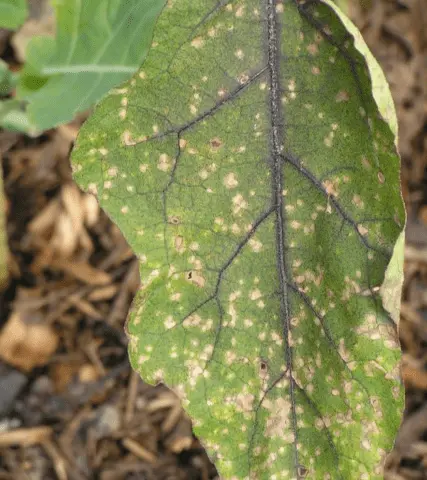
Cercosporosis spreads along with wind, water
It is possible for the infection to penetrate through garden tools, with the help of which eggplants are cared for in the open field. For treatment use such drugs:
- “Bordeaux liquid”;
- “Abiga Peak”;
- “RAW”.
Phomopsis
Phomopsis is a fungal disease of eggplant in the open field, which is widely distributed in hot weather. Main features:
- browning;
- rotting of seedlings;
- ring rot on the root neck;
- spots on brown leaves next to the veins;
- brown spots appear on the fruits.
When grown outdoors, the disease is transmitted by precipitation, wind, and insects. It is dangerous that many fruits can rot and become unsuitable for human consumption. Treatment is carried out with the help of fungicides based on mancozeb, chlorotonil, prochlorase.

Fruit affected by Phomopsis should be disposed of
Alternariosis (gray rot)
Alternariosis is another dangerous eggplant disease. Found outdoors and in greenhouses. A fungal infection manifests itself with the following symptoms:
- brown spots on leaves;
- wet areas on the fruit, causing them to spoil and soften, turning black or olive gray.
Fungi penetrate through mechanical damage and burns on the fruit. The pathogen overwinters in the soil for two seasons. Affected bushes are difficult to cure – it is better to dig up and discard. In the early stages, you can try to treat with a solution of colloidal sulfur or copper-based preparations.
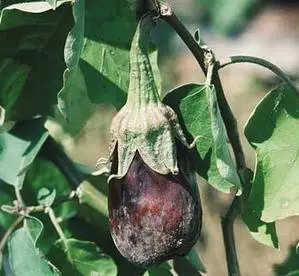
Gray rot of the fruit leads to the death of the crop
Sclerotinia (white rot)
Sclerotinia is a fungal disease of eggplant in open ground. It is also called white rot, since the main symptom is the appearance of a whitish coating on the stem. Inclusions are noticeable on it – these are sclerotinia. Gradually, the tissues soften, water and nutrients stop flowing, and the bushes die off.
The fruits also soften, become watery. Often they have a whitish coating. To get rid of the disease, all the affected parts are removed, the places are sprinkled with wood ash, and then they are treated with Bordeaux mixture or other copper-containing fungicides.
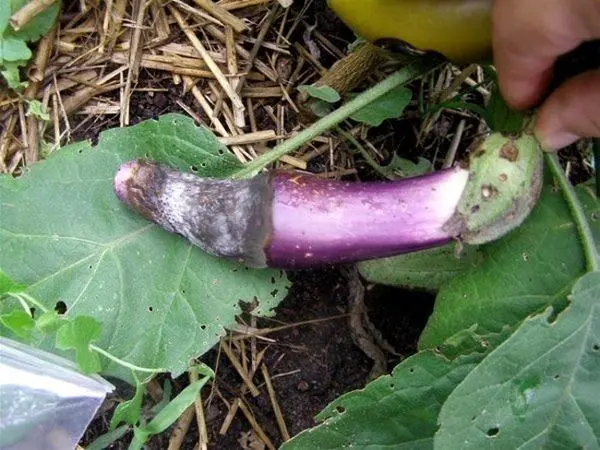
White rot of eggplant causes fruit softening
Fuzarioz
Along with verticillium, fusarium causes yellowing of eggplant leaves. And this fungal disease is even more dangerous. It is mainly found in greenhouses, less often in open ground. It spreads during the fruiting stage.
The pest penetrates from the soil through the root system, spreads through the vessels and begins to release toxic substances. As a result, signs of toxicosis develop – leaf necrosis, wilting of the bush. And it spreads from the top. Also, the source of the disease can come through the eggplant fruit.
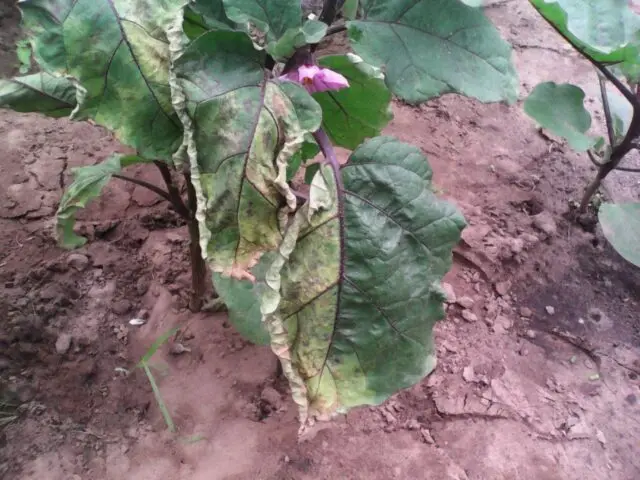
Signs of fusarium – wilting foliage
There are no adequate treatments for this fetal disease. At the first detection of symptoms, the affected plants are dug up and destroyed, and the soil is replaced with a new one. Moreover, the soil should be etched with biological or chemical means:
- “Trichophyte”;
- “Bordeaux liquid”;
- Fitosporin-M;
- Trichodermin.
Antraknoz
Unlike many others, this outdoor eggplant disease is associated with two types of fungi at once. And the symptoms are about the same:
- Oval spots of brown or dark gray color appear on the foliage, their edges are blurred.
- Dark depressed areas are formed on the fruits (1 cm in diameter).
- Also, black formations in the form of pads with brown spots are noticeable on eggplants – they affect most of the fruits, which is why they crack.

Fruit affected by anthracnose is not used for cooking
The spread of the disease is associated with conidia that remain in the soil and on plants. And the infection goes from spring to autumn. For prevention, it is necessary to observe crop rotation, watering rates, and also not to plant eggplants too tightly. Treatment is carried out with the help of copper-containing preparations.
Virus diseases of eggplant
Viral diseases in the open field are also spread by precipitation and wind. The provoking factor is the decrease in temperature. If the summer is cool and rainy, the risks increase significantly. Another feature of viral diseases is that they are not treatable. Therefore, it remains only to dig up the bushes, take them away and destroy them.
The main viral pathology is mosaic, it is often carried by insects and through inventory. The virus is quite resistant to adverse temperatures, dryness. Moreover, it remains in the open field for several years. There are several varieties of this disease:
- Tobacco mosaic – pale yellow spots appear on the leaves. The process of photosynthesis is disrupted, after which the damage passes to other parts of the plant. The affected areas dry up, the leaves curl up into tubules. The fruits on diseased bushes are small, deformed.
- Cucumber mosaic is another viral disease of open ground, due to which not only light, but also dark spots appear on the leaves. In appearance, they resemble rot. The bushes turn out to be dwarfed, covered with blisters. However, they do not bear fruit.
- Mottled mosaic – spots on the leaves of light green color, then turn brown. Holes form in their place. Plants die, the virus is not treatable.
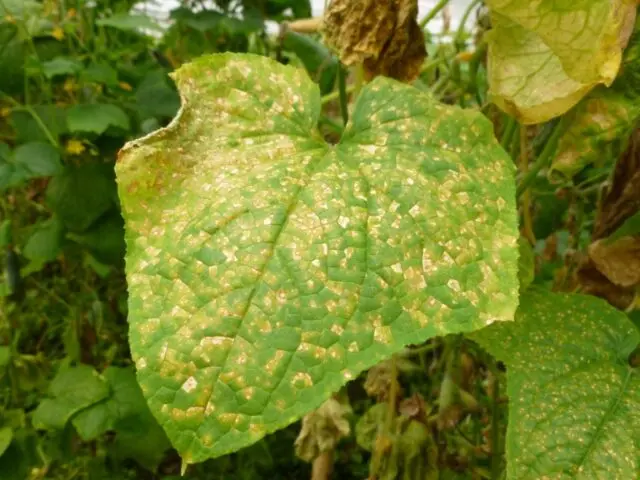
Mosaic-affected leaf looks mottled
Bacterial diseases
Bacterial diseases of eggplants in the open field are also common. The most dangerous are blossom end rot and spotting.
Vertex Rot
This pathology is not so common – it mainly affects peppers and tomatoes. However, eggplant can also be affected by a bacterial infection. First, watery spots of a greenish or grayish color appear on the lateral parts of the fruit. The surface is covered with wrinkles, the fruits become unsuitable for food.
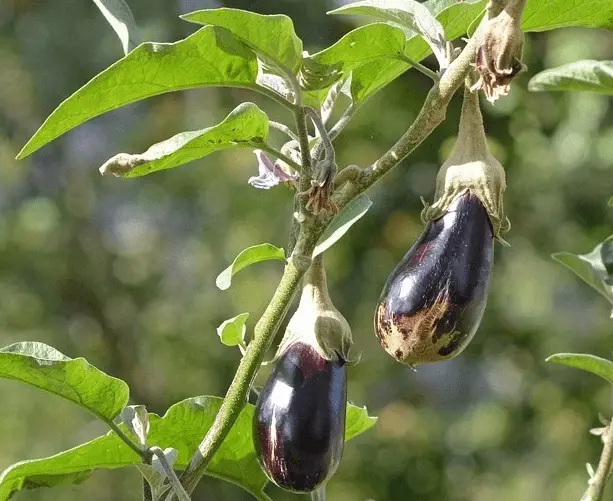
There is no adequate treatment for blossom end rot – the affected bushes are thrown away.
The soil on the site is changed. For prevention, seeds before sowing seedlings should be pickled in a solution of potassium permanganate.
Bacterial spotting
This pathology affects the entire terrestrial part of plants. It manifests itself as small black spots on the leaves (up to 3 mm in diameter). On stems, petioles, these spots are drawn out. Points with watery edges are noticeable on the fruits. They can increase up to 8 cm, resemble ulcers.
It is impossible to treat eggplant for this disease, since there is still no effective treatment. Affected bushes are thrown away. The main preventive measures are crop rotation and seed dressing.
Prevention of eggplant diseases
Preventing eggplant diseases is much easier than treating them. As a preventive measure, gardeners with experience recommend listening to the following tips:
- Before sowing, treat the seeds in potassium permanganate or a fungicide solution.
- Do not plant too thick – there should be at least 30 cm between adjacent bushes.
- Do not violate the watering rate – eggplants are given water every 5 days in the amount of 10 liters per square meter.
- Fertilize regularly – after planting in open ground, during flowering and the formation of ovaries. It is best to alternate complex mineral compositions with organic matter (mullein, bird droppings).
- Observe crop rotation – do not plant eggplant after nightshade (tomatoes, potatoes, peppers). The best predecessors are onions, cucumbers, different types of cabbage, perennial herbs.
Conclusion
Eggplant diseases in the open field manifest themselves against the background of adverse weather and violations of the rules of care. Even with proper agricultural technology, the development of infections is not excluded. Therefore, the bushes should be periodically inspected and, if necessary, immediately treated with drugs.










